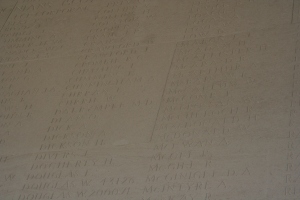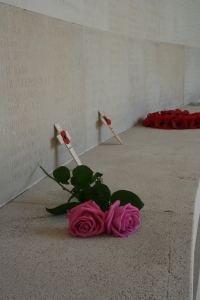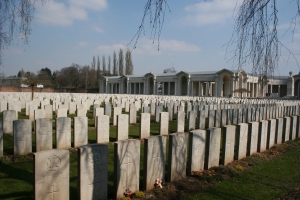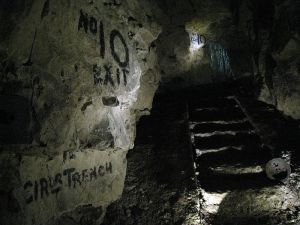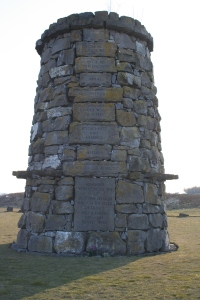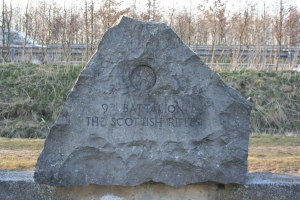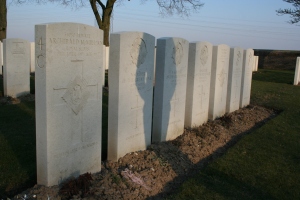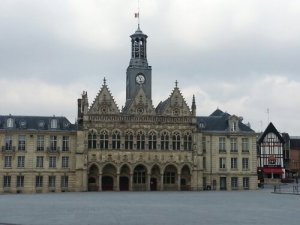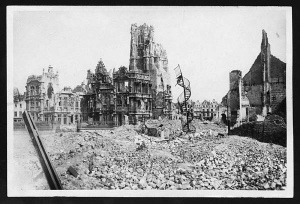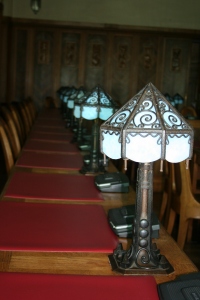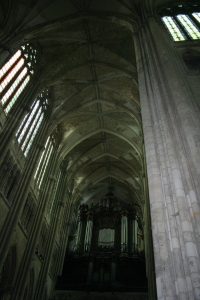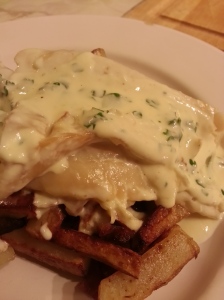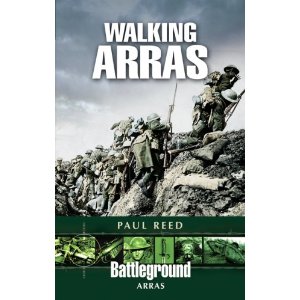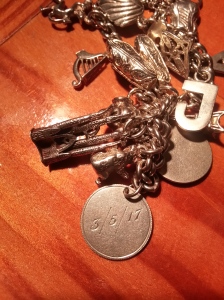My Great War journey is at an end
Thank goodness the broadband is back – I felt like I was letting you all down yesterday.
So tonight’s blog will be all about tying up the loose ends to William’s final month before the sniper got him as he stepped out of the Cuba trench on May 3, 1917.
The first piece in the jigsaw was following the navigation on my phone from Calais to Saint-Quentin. On the main motorway as we by-passed Arras the familiar double loops of the turn-offs from Paul Reed‘s map shone bright on my phone. We were driving over where the Cuba trench had been and all around us was the battleground where William and so many men lost their young lives.
We chose Easter Monday to visit the Arras Memorial but first I popped into one of the many florists in the area of Saint-Quentin where we were staying. I ordered two pink roses – deep pink is for respect and gratitude but that barely covers how I feel.
The Arras Memorial is next to the Citadel which is a UNESCO world heritage site. We drove round it looking for a parking space and at one point I asked to get out for a look at something. I’m not sure what drew me to it but there was a steep descent into an area almost like a walled garden which is a memorial to the hundreds of men shot there and left in ditches during WW2. We eventually found a place to park and headed for the memorial. There’s a huge engraved stone on the wall at the entrance and it puts everything into perspective. Aside from the marked graves the memorial commemorates the lives of nearly 36,000 men who have no known grave – and that’s just the ones who lost their lives in the Battles of Arras, not the Somme, not Passchendaele, not Ypres.
Even though we had a map of the memorial and details of the bay we’d find his name in, the sheer scale of the place made it difficult to get any bearings. All around the semi-circular walls there are names, at the base people have left flowers, crosses and old sepia photos of sons, brothers, fathers and uncles. We eventually found his name up high in Bay 6, along with the others in his battalion who lost their lives and were never found.
I left the roses there, one from me, one from my mum and that’s when the tears started with both of us. We never knew William but the magnitude of the whole thing just got to us. We could also put ourselves in my great gran’s shoes when she got the knock on the door to say her son would never be coming home. We were the first in the family to have the chance to make that journey, so we cried for everyone who had known him.
We took a last sombre look round to pay our respects and again the graves brought it home to us how many gave their lives.
From there we headed to Arras town square to decide what we were going to do next. I’d picked up a leaflet from the folder in the house we were renting which was in French but looked interesting. It was a museum which had opened in 2008 and although I didn’t think it would have much relevance to William’s story I fancied a gander.
Carriere Wellinton is part of a mediaeval warren of chalk quarries 20m under the pavements of Arras. Although abandoned the British got wind of their existence and worked out that part of them came up a few metres from the German line. In true Baldrick style they hatched a cunning plan to make them safe, using the mining talents of the troops from New Zealand and the North of England.
When we got to the reception one of the guides, whose English was so good he could crack mother-in-law jokes, asked if we were there as tourists or if we had a personal reason for the visit. When I pulled out the research I’d done before I left home he took it from me and said he’d do some more research while we were doing the tour.
We were given headsets so the French bits in the commentary would be translated into English. We then headed down in a group of about 20 people with a guide, into the dark and the damp of the quarry.
You’re taken along wooden duckboards then brought out onto pontoons where there are fabric screens where they show old footage and photos of the soldiers. There are also exhibits of old bottles and tins found down there as well as tabletops with the war manoeuvres and the plans of those in charge. You can see inscriptions in the chalk with place names to remind the men of home and there are even drawings of sweethearts back in Blighty. The element of true surprise was dashed in the end as the Germans retreated a bit shortly before the British and Commonwealth troops came above ground. They still won ground though and, had the generals kept on with the advance the Battle of Arras may have been a lot less bloody, but they took the decision to wait a day before pressing on. Had they kept on William may have survived, but then we wouldn’t have made the journey to France.
After the tour there’s a short film. Again the tears welled up as we were told that they were losing 4000 men a day at the height of the fighting.
The chances are that William was in one of the many parts of the quarry – only a fraction of it is the museum – we may even have walked in his footsteps. As we left to go back upstairs this is the sign that left me thinking.
When we got back to the shop the guide (I’m ashamed to say I didn’t ask his name but I will track him down somehow) had done his research and gave me a printout of a map with the advances William’s brigade made during the Battle of Arras.
He also showed us a book about the archaeology that’s been done in the area from the TGV line being laid and the motorway being built to the clearing of a site close to Arras and the quarry to build an industrial estate. He pointed out that the leapfrog advances William would have made were on the very ground that the book was about and also showed us that there is a cairn just across the motorway from the industrial estate, dedicated to all the Scottish divisions who fought. The stones had been shipped over from all the areas the men came from and was built to copy the cairn in Culloden. He said that if we made the trip across the field we’d really be stepping in William’s shoes. We had to do it. I bought two copies of the book, one for me and one for Lizzie at the museum in Hamilton to thank her for her help.
We headed off in the car and after two circuits of the motorway we eventually found the dirt track to the cairn by cutting through a housing estate.
We stood in silence at the cairn, looked for the stone to commemorate the Cameronians, then headed for the cemetery which is next to the cairn.
Most of the graves are for soldiers who couldn’t be identified, probably because they were buried quickly before being transferred to a proper cemetery. Most wore leather dog tags which disintegrated very quickly. One man Archibald McMillan, who served with the Royal Scots, for some reason had the foresight to get his made of metal and sown into his uniform. He died and would never have been found had it not been for the careful archaeological digs done on the industrial site. When they found his body they managed to trace his son who was born after Archibald died. Aged 91 he attended his father’s funeral and his last resting place is the cemetery at Point du Jour – I can’t think of anything more tragic and moving.
As we looked at the other unmarked graves and realised how close Point du Jour is to the Cuba Trench it dawned on us all that William is probably in one of those graves. It may just be wishful thinking but in our own hearts and minds we can lay him to rest there.
So that’s it – I’ve done my detective-who-do-you-think-you-are bit. Our journey is at an end and William can rest in peace knowing that we did our best to find him. I’m guessing that many more people will make the pilgrimage over the next few years, given that next year marks the centenary beginning of the Great War. If I can help anyone I will – I may even make the trip again myself.
Ever with my council hat on I have a meeting at the end of the week to see if we can twin our museum with Carriere Wellington as I think we can help each other understand the joint story that bit better.
I’d also like to take this opportunity to thank Paul Reed for his invaluable help.
For the full story you could also read William’s Extra Ordinary Story and Who Do I Think I Am?
Form all that I learned:
- always ask people’s names because you may need them again
- never give up the scent till it lets go of you
- never give up when you can see something but you just can’t work out how to get to it
- always act on hunches
- listen to your inner voice – it might just be someone else trying to get your attention
Today’s track
The original Karen O, although I totally love Karen O too!
Today’s recipe
Cabbage, chorizo and prawns
Serves 2
When I read this in Nigel Slater’s Kitchen Diaries II I couldn’t actually imagine the flavours together but I have to say it’s the tastiest dinners I’ve had in a long time and that’s saying something.
Ingredients
a little olive oil for frying
1 chirozo, cut into chunks on the diagonal
1 sweetheart cabbage, shredded
1 pack of prawns
a splash of cider (I added this myself because I wanted sauce to mop up with my baguette)
Heat the oil in a frying pan and fry the chorizo till its crispy on the outside and has given up its red juices to the pan. Add the cabbage and the prawns of their raw and cook till the cabbage is starting to wilt at the edges. Add the cider and heat till the prawns are cooked. If the prawns are pre-cooked add at the last minute to heat through.
I tweeted my cider addition to Nigel and he said it was a brilliant stroke so I’m taking that as a great compliment 🙂


